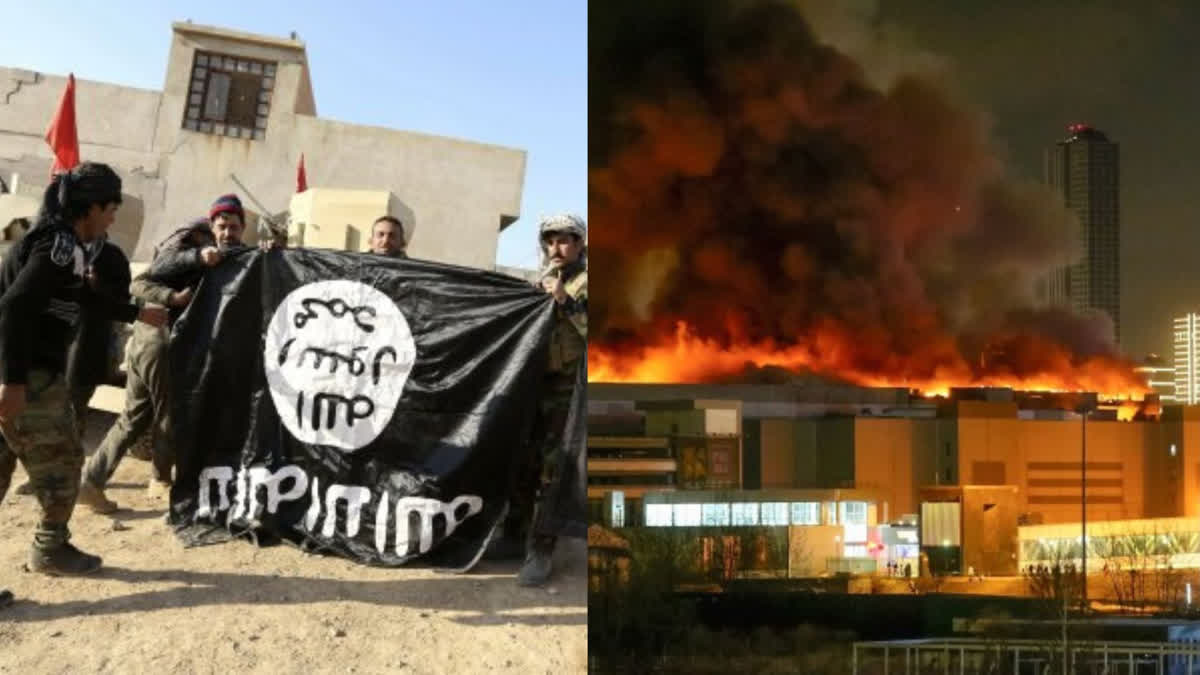New Delhi: Following the deadly terror attack in a concert hall in Moscow Friday night that killed least 115 people, the Islamic State-Khorasan (ISIS-K) outfit has claimed responsibility.
While the Islamic State militant group claimed responsibility for the attack through a statement released on their affiliated social media channels, neither the Russian government nor its security agencies have officially attributed blame for the incident.
In a statement published by the Islamic State’s Aamaq news agency, the group’s affiliate in Afghanistan asserted that they had carried out an attack targeting a large gathering of “Christians” in Krasnogorsk. However, the authenticity of this claim could not be immediately verified.
Nonetheless, a US intelligence official informed The Associated Press news agency that American intelligence agencies had corroborated that the Islamic State was indeed responsible for orchestrating the attack.
So, what exactly is the ISIS-Khorasan? When did it first emerge?
ISIS-Khorasan, also known as ISIS-K or Islamic State Khorasan Province (ISKP), is a regional affiliate of the Islamic State terrorist group that operates primarily in Afghanistan and Pakistan.
ISIS-Khorasan emerged in late 2014 after pledging allegiance to ISIS leader Abu Bakr al-Baghdadi. It is composed of former members of the Pakistani Taliban, Afghan Taliban fighters, and other militants from the region.
The group shares the same ideology as the Islamic State, aiming to establish an Islamic caliphate governed by Sharia law across the Khorasan region. Khorasan was a medieval Islamic empire that covered the areas of present day Iran, Afghanistan and the Northwest Frontier Province of British India.
The extent of the region referred to as Khorasan varied over time. In its stricter historical sense, it comprised the present territories of northeastern Iran, parts of Afghanistan and southern parts of Central Asia, extending as far as the Amu Darya (Oxus) river. However, the name has often been used in a loose sense to include a wider region that included most of Transoxiana (encompassing Bukhara and Samarqand in present-day Uzbekistan), extended westward to the Caspian coast and to the Dasht-e Kavir southward to Sistan, and eastward to the Pamir Mountain.
The ISIS–Khorasan began with the dispatch of Afghan and Pakistani militants from Al Qaeda-aligned groups to the Syrian civil war, who returned to the region with instructions and funding to recruit fighters for a branch of the Islamic State in the Khorasan region. They recruited from former dissatisfied fighters and dissenters of the Taliban. The group’s traditional base of power began and remains in eastern Afghanistan along the border with Pakistan.
The ISIS-Khorasan’s first emir (leader) was Hafiz Saeed Khan, a former Pakistani Taliban commander, who was killed in 2016. The current leader is unknown, as the group has not publicly announced a successor after several leadership decapitations. The ISIS-Khorasan is organised into separate regional branches or “provinces” in Afghanistan and Pakistan, with each having its own command structure and operational capabilities.
What are the ISIS-K’s areas of operation?
The group’s primary areas of operation are in eastern and northern provinces of Afghanistan, such as Nangarhar, Kunar, Nuristan, and Jowzjan. It also maintains a presence in various regions of Pakistan, particularly in the tribal areas along the Afghanistan-Pakistan border.
ISIS-K is known for carrying out high-profile suicide bombings, targeted assassinations, and attacks against both civilian and military targets.
ISIS–K has conducted numerous high-profile attacks against civilians in Afghanistan and Pakistan. Some of its most notable attacks include a suicide bombing in August 2021 that killed 13 American military personnel and least 169 Afghans in Kabul during the US withdrawal from the country, twin suicide bombings in July 2018 that killed at least 131 at election rallies in Pakistan, twin bombings in July 2016 that killed 97 Hazara protestors in downtown Kabul, a suicide bombing in July 2023 that killed 63 in Khar, Pakistan, during a Jamiat Ulema-e-Islam-F (JUI-F) rally.
While the majority of ISIS–K attacks occur in eastern Afghanistan and western Pakistan, the group has claimed to have fired rockets into Afghanistan’s northern neighbours, Tajikistan and Uzbekistan. In early January 2024, two ISIS–K attackers carried out twin suicide bombings in Kerman, Iran, during an event mourning the US assassination of Quds Force leader Qasem Soleimani. The attack, which killed 94, was ISIS–K’s first beyond the borders of the Afghanistan–Pakistan region.
Today, ISIS–K is engaged in a protracted, low-intensity conflict with the Taliban regime in Afghanistan. Though the Taliban and ISIS–K actively fought against the US, since the US withdrawal, ISIS–K has shifted its efforts to discredit, destabilise, and overthrow the Taliban regime in order to establish its envisioned Islamic caliphate. The Taliban, on the other hand, make efforts to target ISIS–K militants through violent raids, protect foreign diplomats and investors from ISIS–K attacks, and publicly downplay the presence of the Islamic State to attract foreign recognition and investment.
So, why did ISIS-K make a concert hall in Moscow a target of its attacks?
This is not the first time that the ISIS-K has made Russia a target of its attacks. In September 2022, the outfit carried out a high-profile suicide bombing near the entrance of the Russian Embassy in Kabul killing at least six people, including two embassy employees. The Russian Foreign Ministry acknowledged that top Russian diplomat Mikhail Shakh and security expert Kuzhuget Adygzhy were killed in the suicide attack.
It is worth noting that Friday night’s attack in the Crocus City Hall came days after Vladimir Putin was re-elected as the President of Russia. The Islamic State has a long-running enmity with Putin. One of the primary reasons for the Islamic State’s opposition to Putin is Russia’s military intervention in Syria. Putin’s decision to provide support to the Syrian government of Bashar al-Assad, including airstrikes against the Islamic State and other rebel groups, directly challenged the outfit’s territorial ambitions in Syria. Russia’s military involvement significantly weakened the Islamic State’s control over territory and hindered its ability to expand.
Portraying Putin as an enemy of Islam and Muslims serves the Islamic State’s propaganda objectives. By framing the conflict in Syria and other regions as a struggle between Islam and its purported enemies, including Putin and Russia, the Islamic State seeks to attract recruits and supporters from Muslim-majority regions, including Russia’s North Caucasus and Central Asia.
Read More



